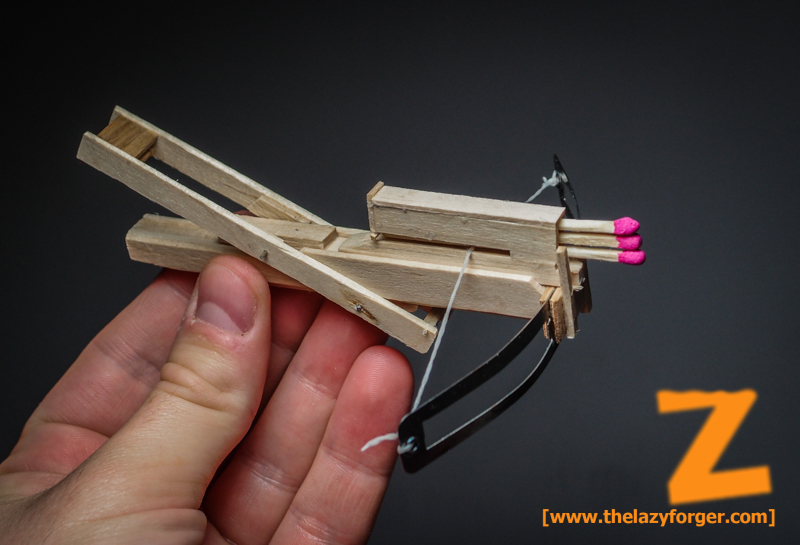
I've been studying historical warfare for a while now, particularly Western and Central Europe in the 15th and 16th centuries. Is this sort of analysis misguided? Did the 6-dan Han-era crossbows have shorter powerstrokes? And the efficiency would likely be much higher, maybe 70-75%. That's most than almost any simple wood bow, though Manchu-style big-ear bows might do better (we need more bow tests too). Even at 50% efficiency it'd manage 168 J of initial energy. Assuming a linear force curve, it'd store about 335 J. 330lbs or so at an 18-or-so-inch powerstroke would make for a powerful weapon, assuming decent efficiency. He also introduced belt-and-hook spanning method, a much needed improvement that allows Chinese crossbowmen to span more powerful crossbows.Ī Han Dynasty-style crossbow trigger mechanism (left) and the improved crossbow mechanism designed by Cheng Zong You (right), from 'Wu Bei Zhi (《武備志》)'.Ħ-dan crossbows were apparently common. He designed a new trigger mechanism that is nearly identical to Han Dynasty design, but replaced the simple "I" shaped rear sight on the trigger mechanism with a more accurate Patridge sight. Late Ming Dynasty martial artist Cheng Zong You (程宗猷) (re)introduced several new technologies to improve the performance of Chinese crossbow. Note that while the drawing above does not depict any visible trigger mechanism, this weapon does in fact have one. When the crossbow need to be repositioned, two Chong Gun are inserted under the wooden frame so that the crossbow can be carried by two (or four) men like a stretcher. One is the shooter, the other a loader, and the third one guards the crossbow. Shen Bi Chuang Zi Lian Cheng Nu is usually operated by three men, each one also armed with a Chong Gun (銃棍). The arrow poison is usually stored inside a box under the wooden frame. It is a multi-shot crossbow that shoots four poisoned arrows at once. Shen Bi Chuang Zi Lian Cheng Nu is a lightweight defence crossbow that is fixed onto a wooden frame. Shen Bi Chuang Zi Lian Cheng Nu (神臂床子連城弩, roughly translated as 'Divine limb bed linked fortress crossbow')ĭrawing of a Shen Bi Chuang Zi Lian Cheng Nu, from 'Wu Bei Zhi (《武備志》)'. Luckily, some decades-old crossbows apparently survived in relatively good condition and rediscovered in the early 1600s. However Shen Bi Nu seems to fall into disuse and essentially forgotten soon afterwards.

Ming arsenals manufactured Shen Bi Nu in limited numbers as late as 1500s. 'Enemy-defeating crossbow'), shoots two or three arrows at once. Ming period Shen Bi Nu may have a draw weight of ninety catties, one hundred twenty catties, or one hundred and fifty catties, depending on its grade.Ī variant of Shen Bi Nu, known as Ke Di Nu (克敵弩, lit. Shen Bi Nu has a prod length of four chi five cun, and shoots a seven cun five fen long crossbow bolt weighing six maces. 'Divine limb bow'), Shen Bi Nu is a crossbow design inherited from Song Dynasty and the first truly military grade crossbow in the Ming army. Finally, 3D computer graphics of two crossbows are presented to illustrate the shooting processes.Also known as Shen Bi Gong (神臂弓, lit. The degrees of freedom of two crossbows are proposed to check the constrained motion.

Then, topological structures of the original crossbow and Chu State repeating crossbow are derived. The Mongolian traditional bow is provided as an example to describe the manufacturing process of the bow. A brief history of the development of the crossbow in ancient China is given. This paper uses the topological matrix to present the topological structures of the original crossbow and the Chu State repeating crossbow. Since the topological structure of the crossbow has a different configuration during the shooting process, it is defined as a reconfigurable mechanism. After the 4th century BC, the technology of producing crossbows was very sophisticated. Because it used the elasticity of the bow and the bowstring to shoot arrows, it was used for long-distance attacks. It was one of the most frequently used weapons during the 5th century BC to the 18th century AD. In ancient China, people integrated the original bow, the bowstring, and a cam mechanism to develop a powerful weapon which was named the crossbow.


 0 kommentar(er)
0 kommentar(er)
